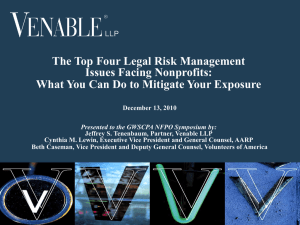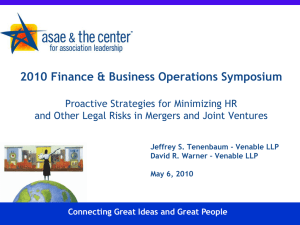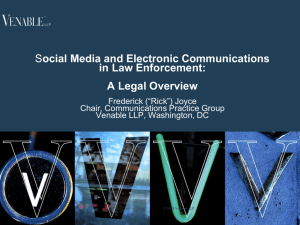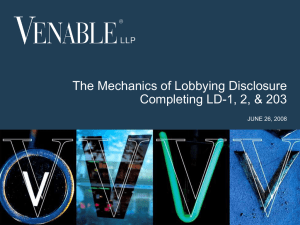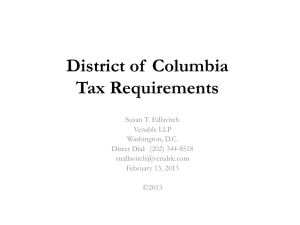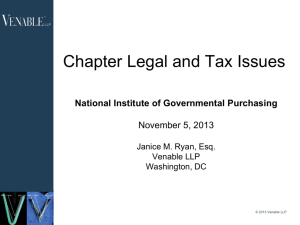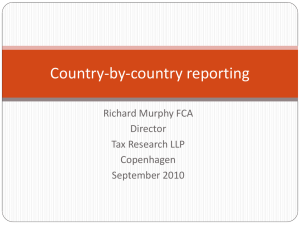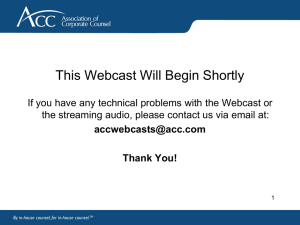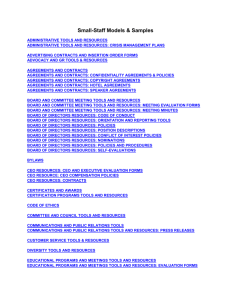Protecting Your Nonprofit from Embezzlement & Fraud
advertisement
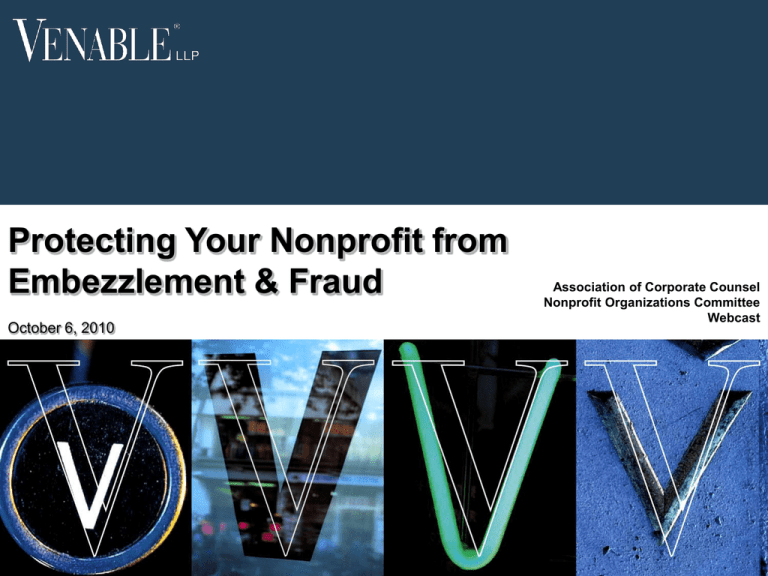
Protecting Your Nonprofit from Embezzlement & Fraud October 6, 2010 © 2008 Venable LLP 1 Association of Corporate Counsel Nonprofit Organizations Committee Webcast © 2010 Venable LLP 2 Kids House of Seminole On June 19, 2010, the former finance director of Kids House of Seminole, a nonprofit that supports children who are victims of abuse and neglect, was accused of stealing $48,000 from the organization by writing checks from the organization to himself, then depositing the money into his personal bank account. The check amounts ranged from a few hundred dollars to two or three thousand dollars. The finance director allegedly admitted to the embezzlement and told investigators that he did it because he was a “compulsive spender.” The agency is reviewing its accounting system and reported that it will make any adjustments necessary. © 2010 Venable LLP 3 Pueblo Hispanic Education Foundation (PHEF) On June 5, 2010, the director of the Pueblo Hispanic Education Foundation (PHEF), a nonprofit that helps local graduates attend college, was arrested for embezzling more than $57,000 from the nonprofit organization. He was charged with two counts of theft, two counts of identity theft and 232 counts of forgery. The executive director used the foundation funds to pay for a Las Vegas trip, patio furniture and $7,500 worth of jewelry, among other personal purchases. The director forged the board president’s name on checks totaling $30,143 in purchases, funneled checks destined for colleges, some that didn’t even exist, into his own personal bank account, and without the 12-member foundation board knowing, he obtained a debit card and spent $27,531 in PHEF funds for personal use. After the arrest, the board of directors learned that the director had pled guilty to theft in 2006 and was on probation for stealing from a Denver nonprofit, the Latin American Educational Foundation. PHEF’s founder stated that the board of directors should have scrutinized the director’s background much closer before hiring him. © 2010 Venable LLP 4 Soundview Health Care Network On April 28, 2010, the Attorney General filed a lawsuit against New York State Senate Majority Leader, Pedro Espada, founder and CEO of Soundview Health Care Network- a non-profit dedicated to providing health care to underprivileged patients. The lawsuit alleges that Espada siphoned $14 million from the organization. Espada is alleged to have used Soundview as his personal and political piggybank. Soundview allegedly paid for $80,000 in restaurant bills for 650 meals for Espada and his supporters; trips for Espada, his wife and his family to Las Vegas, Miami and Puerto Rico; an unlimited line of credit on a corporate American Express card (from 2006 to last year, Espada supposedly charged more than $450,000 in items he later identified as personal); and a housing allowance for Espada of $2,500 per month to pay for a Bronx apartment. Espada also created a janitorial service, put his son in charge of it and is accused of rigging bids to make sure that the company won the Soundview contract -- worth $400,000 annually. The Soundview board was filled with Espada's family and close associates. © 2010 Venable LLP 5 Tremont Community Council Home Attendant Program On April 13, 2010, the former program director of Tremont Community Council Home Attendant Program pled guilty in federal court to embezzling $900,000 from the organization. Over a four year period, he made multiple unauthorized wire transfers from a Tremont account to a personal account in his name, and wrote multiple checks payable to himself on the Tremont account. The wire transfers and checks totaled in excess of $570,000. The former program director also made unauthorized wire transfers totaling approximately $135,000 from the Tremont account to an architect to pay for renovations and other architectural work at a nightclub in the Bronx and at a residence in New York -- both of which he owned. He also had hundred of thousands of dollars transferred from the Tremont account to accounts held by a Manhattan law firm and one of its principals -$258,000 of that money was later transferred to the program director through checks drawn on an escrow account in the law firm's name. He faces a maximum sentence of 10 years in prison and a maximum fine of $250,000 or twice the gross gain from the offense. © 2010 Venable LLP 6 Iowa Association of School Boards On April 1, 2010, the executive director of the Iowa Association of School Boards was terminated because she took a salary increase of over $100,000 without board approval. The executive director was caught because one of the board members, against the executive director's instructions, communicated with the auditors and verified the salary increase. Upon closer investigation, it was discovered that the executive director: – – – – Provided raises to a few employees while other employees were being terminated for financial reasons; Prevented IASB's auditing firm from providing the board with information necessary to carry out its fiduciary duties -- going so far as to direct an attorney to threaten the auditors if they attempted to communicate with the board; Violated board policy by failing to utilize competitive bidding for projects where expenditures were over $10,000; And failed to obtain board approval for projects with expenditures over $75,000. The Iowa Legislature’s Government Oversight Committee has issued a subpoena to the executive director. © 2010 Venable LLP 7 Why Does Employee Fraud Occur? Motivation Rationalization Opportunity © 2010 Venable LLP 8 Why Does Employee Fraud Occur? Motivation – – Rationalization – – Economic factors such as personal financial distress, substance abuse, gambling, overspending, or other similar addictive behaviors may provide motivation. The current national economic recession may serve to increase the incidence of such financial motivations. The employee finds a way to rationalize the fraud. Such rationalizations can include perceived injustice in compensation as compared to their colleagues at for-profit enterprises, unhappiness over promotions, the idea that they are simply “borrowing” from the organization and fully intend to return the assets at a future date, or a belief that the organization doesn’t really “need” the assets and won’t even realize they are missing. Opportunity – The employee has sufficient access to assets and information that allows him or her to believe the fraud can be committed and also successfully concealed. © 2010 Venable LLP 9 Why Are Nonprofits Frequently the Victims of Embezzlement? Management and board members are often more trusting Less stringent financial controls for nonprofits A belief that audits will catch any fraud © 2010 Venable LLP 10 Strong Compliance Program The best way to prevent embezzlement and to protect an organization given the nature of respondeat superior liability is a comprehensive and vigorous compliance program that must be more than a “mere paper program.” Company Handbook Any effective compliance program will: Be tailored to the specific organization, such that the controls mitigate the risks inherent in that organization’s business and address any applicable government regulations and industry standards. Include a corporate code of ethics. The organization’s commitment to ethical behavior should be clearly and concisely communicated to the board, management and employees. This commitment to the code should be affirmed by all employees on a periodic and ongoing basis. Be owned by senior management. Management must be proactive. The Board must have ultimate oversight and control of the program. Provide for regular education and training for directors, management, employees, volunteers and staff. Your organization’s compliance policy outlined here 2010 con’t © 2010 Venable LLP 11 Strong Compliance Program Be regularly monitored and audited to ensure that it is working. Contain effective means to report violations and concerns, such as whistleblower hotlines or other anonymous reporting mechanisms. Provide for meaningful discipline for violation of the policy. A reputation for aggressively investigating fraud can have a strong deterrent effect while a reputation for ignoring possible fraud is an invitation to commit fraud. Company Handbook Your organization’s compliance policy outlined here 2010 Require that appropriate steps are taken if a crime occurs. Address any control weaknesses uncovered. © 2010 Venable LLP 12 Control Measures to Consider #1 Multiple layers of approval will make it far more difficult for embezzlers to steal from your organization. For expenditures over a pre-determined amount, require two signatures on every check and two authorizations on every cash disbursement. Consider having an officer or director be the second signatory or provide authorization for smaller organizations. With credit cards, require prior written approval for costs estimated to exceed a certain amount. The person using the credit card cannot be the same person approving its use. Have a board member or officer review the credit card statements and expense reports of the Executive Director, CFO, CEO, etc. © 2010 Venable LLP 13 Case Example The Financial Director of Kids House of Seminole would not have been able to steal $48,000 if the organization had implemented a control requiring that two signatures were necessary © 2010 Venable LLP 14 Control Measures to Consider #2 All check and cash disbursements must be accompanied by an invoice showing that the payment is justified. If possible, the invoices or disbursement request should be authorized by a manager who will not be signing the check. Only pay from original invoices. © 2010 Venable LLP 15 Control Measures to Consider #3 Many nonprofits do this if the executive director is going on vacation. Keep blank checks and signature stamps locked up. CASE EXAMPLE An assistant to an executive director of a nursing home had the directors signature stamp locked in her drawer. She stole millions of dollars from the organization by writing checks to herself and using the director’s signature stamp. The director never looked at the checks. © 2010 Venable LLP 16 Control Measures to Consider #4 One individual should not be responsible for an entire financial transaction. Money Coming In: No single individual should be responsible for receiving, depositing, recording and reconciling the receipt of funds. Money Going Out: No one person should be responsible for authorizing payments, disbursing funds, and reconciling bank statements. If the organization does not have enough staff on hand to segregate these duties, a board director or officer should reconcile the bank and credit card statements. Require employees who hold financial positions to take an uninterrupted vacation for two weeks – do not let them work from vacation – This permits transactions to clear properly in their absence. If you have an employee who refuses to go on vacation – that could signal a problem. © 2010 Venable LLP 17 Control Measures - Case Example Former vice president for finance at large national nonprofit. – Worked there for 20 years – Embezzled $11.9 million Wrote checks to herself, forging the signatures of the required co-signers. – Destroyed the canceled checks when the bank mailed them back to her No one noticed because she also kept the organization's books. She was able to cover up for the losses by inflating the reported amount of unfulfilled pledges. Had someone else reconciled the bank statements, she would not have been able to destroy the checks that she had written to herself. Or, if someone else were responsible for unfulfilled pledges, she would not have been able to cover up the losses. © 2010 Venable LLP 18 Control Measures to Consider #5 Background checks on new employees and volunteers are important. Many organizations skip this basic step. The Association of Certified Fraud Examiners reports that 7% of embezzlers have been convicted of a previous crime. Background checks can reveal undisclosed criminal records and prior instances of fraud, allowing you to avoid a bad hire in the first place. They are also fairly inexpensive, and should be made a part of your hiring process. CASE EXAMPLE A thorough background investigation by the Pueblo Hispanic Education Foundation would have likely revealed that the candidate had pled guilty to embezzling money from another nonprofit © 2010 Venable LLP 19 Control Measures to Consider #6, #7, #8 Fair Bidding Process – – All contracts should be subject to at least three bids, and approved by a manager uninvolved in the transaction. Large contracts should be reviewed and voted on by the board. Fixed Asset Inventories – – Conduct a fixed asset inventory review at least once per year to ensure that no equipment (computers, printers, etc.) is missing. Record the serial numbers of the equipment and consider engraving an identifying mark on each item in case of theft. Audits and Board Level Oversight – Regular audits will not catch every instance of fraud, however, they are critical to prevent fraud and there should be board level review, if not oversight, of the audit. © 2010 Venable LLP 20 Control Measures to Consider #9 Provide a means of anonymous communication. Employees may not report theft or mismanagement if they believe their job is in jeopardy. Employees must have a manner in which to contact a board member in the event something needs to be reported, and they do not feel comfortable reporting to management. Board members must be prepared to take these reports seriously, keep the reporting employee protected and contact legal counsel. © 2010 Venable LLP 21 Control Measures to Consider #10 Management, including directors and officers need to “set the tone at the top” for ethical behavior Management must set a good example for fair and honest business practices © 2010 Venable LLP 22 © 2010 Venable LLP 23 Venable’s Team William H. Devaney 1270 Avenue of the Americas 25th Floor New York, NY 10020 wdevaney@Venable.com T: 212.307.5500 Jeffrey S. Tenebaum 575 7th Street, NW Washington, D.C. 20004 jstenenbaum@Venable.com T: 202.344.8138 Doreen S. Martin 1270 Avenue of the Americas 25th Floor New York, NY 10020 dmartin@venable.com T: 212.307.5500 Venable LLP is an AmLaw 100 firm with over 600 attorneys across the country practicing in all areas of corporate and business law, complex litigation, intellectual property and regulatory government affairs. The firm's clients represent a broad spectrum of industries and organization types, ranging from entrepreneurs and emerging growth companies to large national and international organizations. California | Maryland | New York | Virginia | Washington, D.C. www.Venable.com 24 © 2010 Venable LLP
